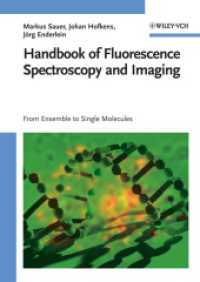Full Description
This special issue of Acta Cytologica focuses on the role of cytology in influencing therapy, directing management, and uncovering new strategies in the complex field of non-small cell lung cancer (NSCLC). With the discovery of the activating mutations in the epidermal growth factor receptor in 2004, a new era of personalized medicine in lung cancer began. Along with these discoveries came a new approach to the care of the NSCLC cancer patient with a direct impact on the practice of cytopathology. In an attempt to guide the cytopathologist and offer strategies to navigate this new era, this issue brings together data and techniques from international experts in diagnostics, testing, epidemiology, and new discoveries. New techniques are highlighted, including expanded use of immunocytochemistry and fluorescent in situ hybridization and use of laser capture microdissection in cytology. A view from interventional radiology, so important in obtaining specimens from cancer patients, is presented and a novel algorithm incorporating microRNA detection in these specimens is discussed. Telecytology as a way to diagnose remotely is explored. A look at NSCLC from the Asian perspective, which has taught us much about mutations and epidemiology, is included. A unique perspective from cytotechnologists who are often at the 'front line' of the battle against this disease is presented. These papers provide an in-depth look at the state of the art, as well as a guide to the future of cytology in the era of personalized medicine.
Contents
Lung Carcinoma in the Era of Personalized Medicine: The Role of Cytology: Zakowski, M.F.; Bibbo, M.; The Utility of Fine-Needle Aspiration in the Diagnosis of Primary and Metastatic Tumors to the Lung: a Retrospective Examination of 1,032 Cases: Adams, J.; Wu, H.H.; Thyroid Transcription Factor 1 and Napsin A Double Stain: Utilizing Different Vendor Antibodies for Diagnosing Lung Adenocarcinoma: Johnson, H.; Cohen, C.; Fatima, N.; Duncan, D.; Siddiqui, M.T.; Molecular Characterization by Immunocytochemistry of Lung Adenocarcinoma on Cytology Specimens: Moreira, A.L.; Hasanovic, A.; Role of Fluorescence in situ Hybridization in Lung Cancer Cytology: Savic, S.; Bubendorf, L.; Semiautomated Laser Capture Microdissection of Lung Adenocarcinoma Cytology Samples: Roy Chowdhuri, S.; Hanson, J.; Cheng, J.; Rodriguez-Canales, J.; Fetsch, P.; Balis, U.; Filie, A.C.; Giaccone, G.; Emmert-Buck, M.R.; Hipp, J.D.; Simple Protocol for DNA Extraction from Archival Stained FNA Smears, Cytospins, and Thin Preparations: Arcila, M.E.; The Interventional Radiologist's Perspective on Lung Biopsy: Elnekave, E.; Thornton, R.; MicroRNA Profiling in Lung Cancer Reveals New Molecular Markers for Diagnosis: Solomides, C.C.; Evans, B.J.; Navenot, J.-M.; Vadigepalli, R.; Peiper, S.C.; Wang, Z.-X.; Circulating Tumor Cells in Lung Cancer: Young, R.; Pailler, E.; Billiot, F.; Drusch, F.; Barthelemy, A.; Oulhen, M.; Besse, B.; Soria, J.-C.; Farace, F.; Vielh, P.; EGFR Gene Mutation Study in Cytology Specimens: Ma, E.S.K.; Ng, W.-K.; Wong, C.L.P.; TeleCyP (Telecytopathology): Real-Time Fine-Needle Aspiration Interpretation: Goyal, A.; Jhala, N.; Gupta, P.; Molecular Diagnostics, Personalized Medicine, and the Evolving Role of the Cytotechnologist: An Institutional Experience: Kane, L.E.; Root, R.R.; Voss, J.S.; Caudill, J.L.; Sorenson, A.M.; Colborn, L.K.; Halling, K.C.; Henry, M.R.; Clayton, A.C.; Kipp, B.R.; Author/Subject Index.







